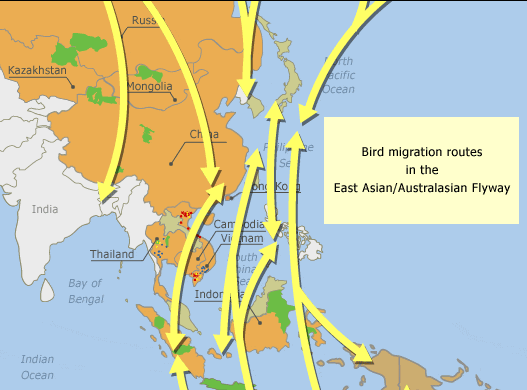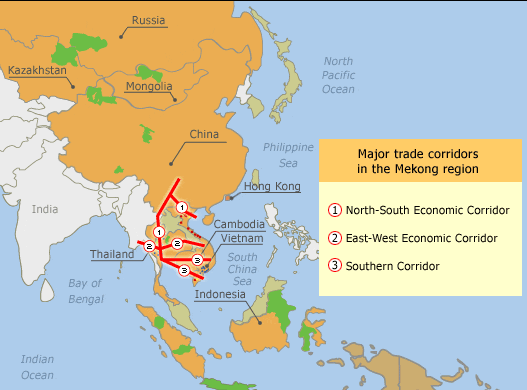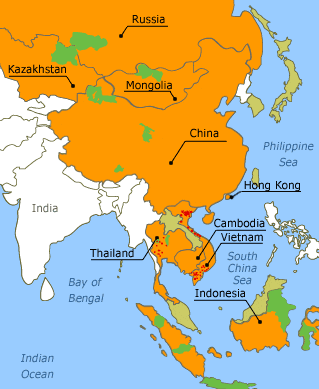Map 1: Human and Animal Cases
Since 2003, 58 people have died of avian flu in Southeast Asia, and unofficial reports coming out of China suggest that the number may be significantly higher. While H5N1 influenza has become endemic in Southeast Asian bird populations (the map shows the current range of the virus), deaths and infections have not, to date, spread rapidly in the human population. In nearly every reported case, humans contracted avian flu via direct exposure to infected poultry. Still, many scientists, physicians, government officials, and others, who have been watching the virus appear in a progressively larger number of countries, fear that the H5N1 virus will inevitably develop into a global pandemic.
As a result, researchers are paying close attention to H5N1’s geographical spread. The disease has been found in wild and domestic birds from the Mekong area to western Russia, on the edge of the Urals and the gateway to Europe. The mechanism of the spread is unclear, however, and hotly debated. While some epidemiologists see wild aquatic fowl as the virus’ private airline, a number of ornithologists feel human trade in birds is a more likely route for the virus, and that wild birds found carrying H5N1 were likely victims of chance encounters with domestic birds, and died before transporting the illness any great distance. Learn about outbreaks in affected countries, and compare the competing theories about bird migration and human trade as vectors for the spread of avian influenza with the following maps.

Map 2: Bird Migration to Blame?
Cases of avian flu in migratory birds that fly along what is known as the East Asia/Australian Flyway (a complicated web of flight paths rather than a single route) have generated substantial concern in the health community. Yet experts are not uniform in their views on the role that migratory waterfowl might play in spreading H5N1 to other species. One of the greatest fears is that infected migratory birds could pass avian flu to humans, especially through their droppings. Migratory birds travel tremendous distances, and countless humans and other mammals could be exposed to their fecal matter without the birds ever setting foot on the ground. Skeptics note that, to date, nearly all human victims of H5N1 have had steady and substantial exposure to infected birds and by definition, migratory birds do not have such human contact. Others question whether any infected birds could survive long enough to continue their migration. They note, for example, that 1,500 migratory birds testing positive for H5N1 were recently found dead at Qinghai Lake in China. However, to date, none of their surviving peers have been known to carry the virus, and no human infections have been reported in connection with this cluster.
Even if migratory birds do not live long enough to spread the virus today, it could all change in the future. Chickens and ducks can now live substantially longer with H5N1 than they could when the strain was first identified, with some ducks reportedly remaining asymptomatic, suggesting that migratory birds might eventually be able to travel longer distances with the virus. And even if migratory birds do not directly infect people, spreading the virus to domestic fowl around the world could have disastrous results. The World Health Organization, the United Nations Food and Agriculture Organization, and other leading international organizations have cited migratory birds as a significant source of concern. Yet they have also noted that attempting to control avian migration is not a realistic option.

Map 3: The Human Factor
The exact role that migratory birds have played and will play in the spread of avian flu is still uncertain. What remains undisputed is that millions of cases of H5N1, along with nearly every instance of transmission to humans, have been traced to domestic poultry. Regardless of the level of risk posed by avian migration, human trade — and illegal trafficking — of birds can foment the spread of avian flu. While domestic birds are limited in their ability to move themselves over large distances, they are easily transported — in small and large numbers, by hand or by truck — from town to town, city to city, and nation to nation. The map indicates prominent land trade routes in Southeast Asia, including regions that have seen outbreaks of H5N1. What is clear on the map is that the overwhelming majority of human cases have occured along these trade corridors.
If the trade and associated transport of birds is a key factor in the spread of avian flu, land routes are not the only potential sources for spreading the virus. In 2004, Indonesia became the first country outside of the Southeast Asian mainland to report cases of H5N1. While it is certainly possible that migrating birds may have carried the virus to Indonesia, the government there has not been aggressive in culling domestic chicken flocks or imposing biosecurity measures to limit the movement of infected chickens, so trade is likely to play a role in the spread of the disease within Indonesia.
Another factor that must be considered is the trade in contraband animals. In December 2003, six ducks smuggled into Taiwan from mainland China were found to be infected with H5N1. Perhaps even more alarming for Western observers, in October 2004, customs officials in Brussels seized two live birds — both rare eagles — from a man’s suitcase. The smuggler had flown to Brussels from Bangkok, by way of Vienna. The birds tested positive for H5N1.

